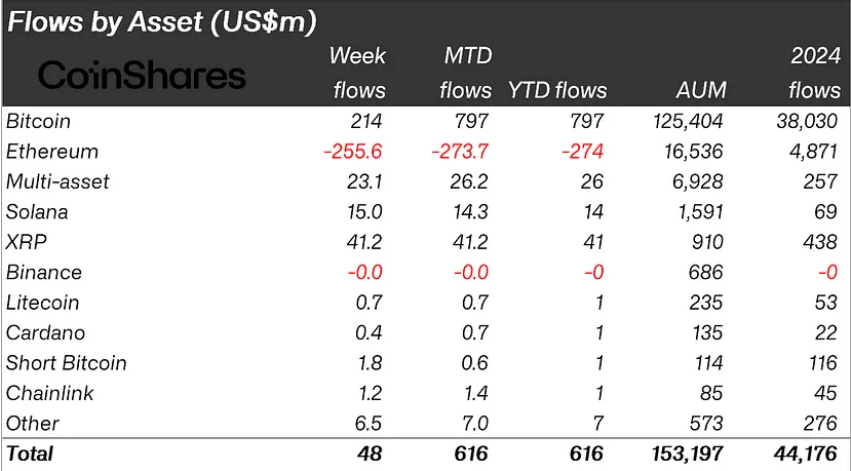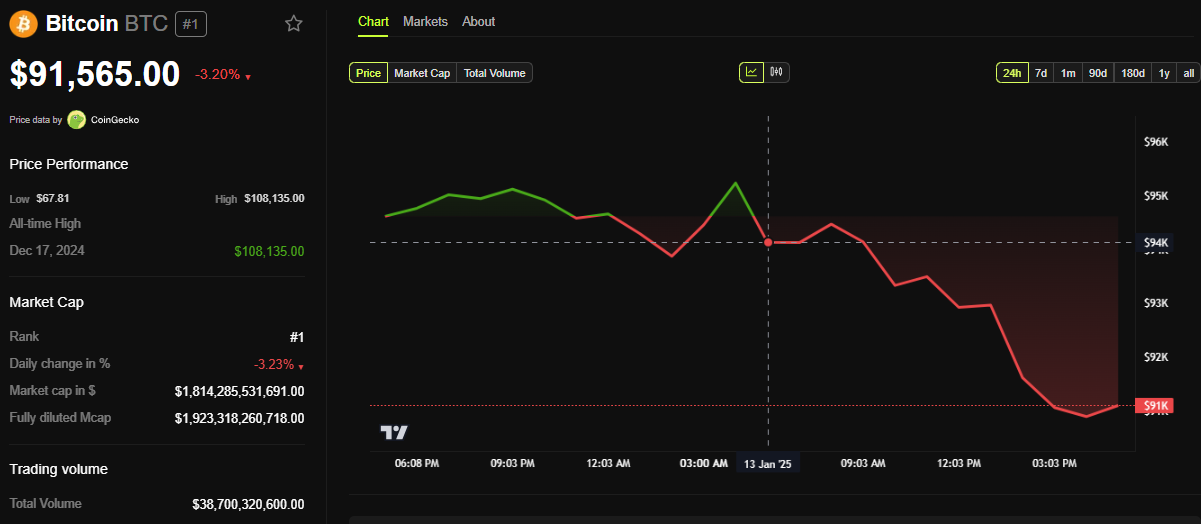Crypto Inflows Shrink to $48 Million Amid Macro and Monetary Policy Woes
- Weekly crypto inflows fell to $48 million, reversing early gains due to hawkish Fed minutes and US macro data.
- Bitcoin recorded $214 million inflows early in the week but faced outflows later; it remains the top YTD performer.
- Investors eye CPI, PPI, and jobless claims this week for clues on inflation, labor trends, and potential Fed actions.
Crypto inflows totaled a modest $48 million last week, reflecting a volatile market response to shifting macroeconomic indicators and recent monetary policy developments in the US.
This significant change compared to the first week of 2025 indicates that the brief post-US election rally may have ended, with macroeconomic conditions once again driving asset prices.
Hawkish Fed Affects Crypto Inflows
The latest CoinShares report reveals that digital assets saw nearly $1 billion in inflows during the first half of the week ending January 11. However, stronger-than-expected macroeconomic data and the release of the US Federal Reserve’s minutes led to outflows of $940 million in the latter half of the week.
“This suggests that the post-US election honeymoon is over, and macroeconomic data is once again a key driver of asset prices,” the report read.
Indeed, the Federal Open Market Committee (FOMC) minutes from last week reflected the Fed’s growing concerns about inflationary pressures. Policymakers are specifically concerned about President-elect Donald Trump’s proposed fiscal policies.
The minutes provided little indication of a potential rate cut in the near term, further solidifying the Fed’s hawkish stance. As BeInCrypto reported, this stance has exerted downward pressure on risk assets, including cryptocurrencies.
Bitcoin, the leading digital asset, exemplified this trend. Despite recording inflows of $214 million earlier in the week, it experienced significant outflows later, mirroring broader market sentiment. Nevertheless, Bitcoin remains the best-performing digital asset year-to-date, with cumulative inflows of $797 million.

The abrupt shift in sentiment disrupted what had been a promising start to 2025. During the first week of the year, crypto inflows reached an impressive $585 million. This momentum seemed poised to continue, but the latest macroeconomic developments have dampened enthusiasm.
With macro trends now back as key market drivers, key US economic data released later this week could influence Bitcoins and crypto sentiment. Specifically, the Consumer Price Index (CPI) and Producer Price Index (PPI) could be pivotal in assessing the economy’s trajectory and, by extension, investor sentiment toward cryptocurrencies.
Investors will closely monitor the CPI and PPI reports, as well as jobless claims, for any signs of easing inflation or labor market cooling. Such data could provide clues about the Fed’s next moves, potentially offering a clearer outlook for digital asset markets.
Despite the recent setback, the long-term outlook for cryptocurrencies remains optimistic ahead of Trump’s inauguration next week.

According to BeInCrypto data, Bitcoin is still holding above the $90,000 psychological level, trading at $91,565 as of this writing. Nevertheless, the odds favor the downside amid fading demand, with some analysts anticipating another leg down for BTC to bottom out around the $70,000 range.
“Playing out textbook Wyckoff Distribution for Bitcoin. We could see $80,000 and even higher $70,000 prices,” one trader wrote.
免責聲明:投資有風險,本文並非投資建議,以上內容不應被視為任何金融產品的購買或出售要約、建議或邀請,作者或其他用戶的任何相關討論、評論或帖子也不應被視為此類內容。本文僅供一般參考,不考慮您的個人投資目標、財務狀況或需求。TTM對信息的準確性和完整性不承擔任何責任或保證,投資者應自行研究並在投資前尋求專業建議。
熱議股票
- 1
- 2
- 3
- 4
- 5
- 6
- 7
- 8
- 9
- 10